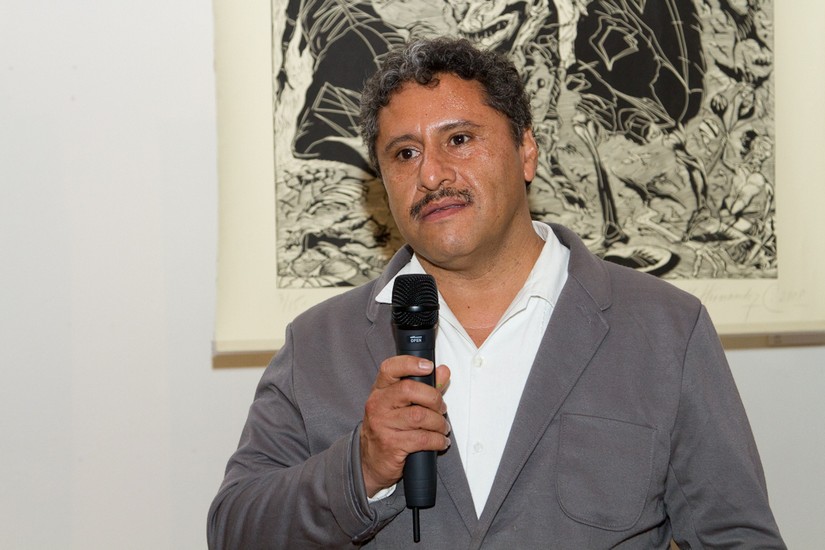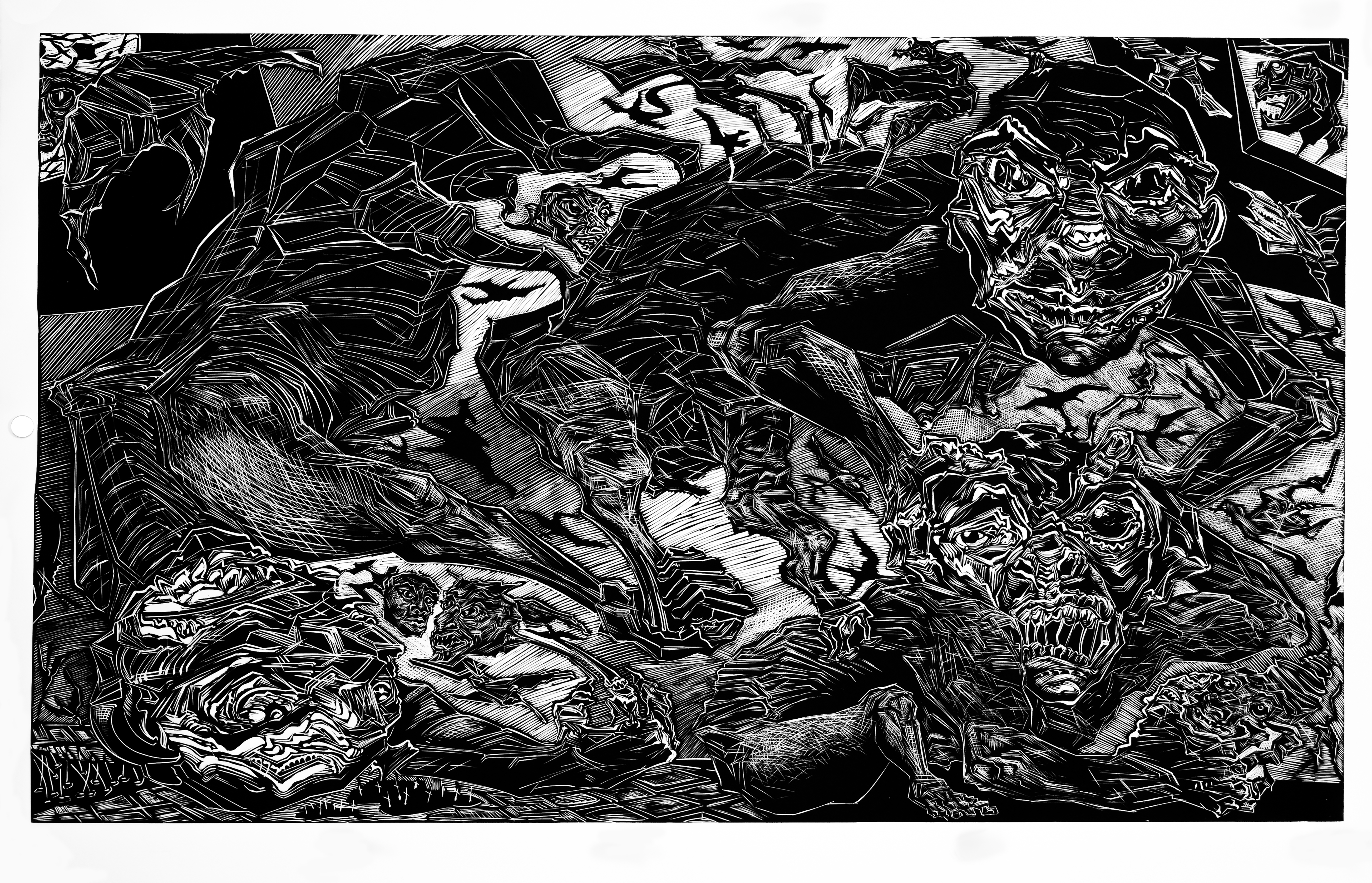
"Víctor Manuel
Hernández Castillo"
Visual arts : 2D, 3D
National Autonomous University of Mexico
Mexico

"Víctor Manuel
Hernández Castillo"
Visual arts : 2D, 3D
National Autonomous University of Mexico
Mexico
CREATIVE WORK
"Vhernandez"

The process shown in my graphics, which involves concepts as well as techniques, is comparable to traveling, where the images reflect current issues. This process also includes formal lines that give structure to space and form in each of my linocuts. When I talk about graphic images, I point to an emotional impulse which brings us a visual script undoubtedly related to poetry.
The poetics of the grotesque, present in the narrative qualities of the linoprints, aim to generate in spectators their own interpretative stories. The process of distortion and disfigurement is progressive in some works, from the calligraphic movement in white lines, while in others, distortion lies dormant in deep blacks.
The linographies carry metaphoric meaning. In my opinion, the narrative is vital, sometimes even becoming anecdotal. I emphasize ironic and hilarious fantasies where humans share traits with animals and machines, creating fantastic hybrid forms—visual metaphors of rationality and irrationality in human materialism.
My current works are closer to oneiric productions, far removed from the limits of logic. I illustrate a dark, troubling atmosphere shaped by my individual perception of daily reality. My graphic work evokes the tradition of the grotesque, as explored by Francisco de Goya, Käthe Kollwitz, and James Ensor, while also drawing deeply from my Mexican heritage.
The interest in the grotesque distorts natural forms, showing human features through animal metamorphosis. The man-animal is a binomial of reason and irrationality. When mixed with machines, it becomes a trinomial: reason–irrationality–technocracy. This hybrid identity reaches its peak from man/machine to machine/man concepts.
I specialize in large linocuts with baroque figurative dynamics and fragmented compositions, which produce richness in greys through the use of line. Touring my work requires careful, prolonged viewing to connect with its storytelling and classical techniques.
Through traditional embossing methods, I innovate contemporary graphic languages, similar to digital means. The medium is not the focus—the creation of new visual forms is. My intention is to show that classical etching and linoleum engraving techniques can lead to innovation.
The narrative in my linoleographic work emerges through relationships among fantastical figures with varying levels of prominence—constructed only through linoleum engraving techniques. Drawing on linoleum begins with imagined prefigurations in lines and spots, finalized by gouge gestures. The engraved drawing becomes something different than the initial pencil sketch.
My graphic creations are metaphorical, sometimes anecdotal. They reference iconography from ancient Aztec mythology—hybrid genealogies of anthropozoomorphism, half-human and half-beast. My linocuts are also inspired by alebrijes, imaginary beings formed from different animal parts. These figures resemble monsters and demons born from the nightmares of contemporary warfare.
My graphic art in linocut and etching is a neo-expressionist language using hybrid human–animal figures, inspired by pre-Hispanic art and popular traditions—masks, alebrijes, and ceremonial dances. It metaphorically portrays human behavioral shifts: animality, power struggles, oppression, and war.
I aim to provoke and immerse the viewer in stories and substories rooted in humanistic–existential reality. I invite reflection on the imbalance between technological rationality and spiritual ethics. Evolution is often followed by involution—Quo Vadis? Where does man go?
This concept led me to explore figurative and iconographic forms through traditional lino printing. Its simplicity allows for spontaneous printmaking in black and white, giving this medium a new voice in contemporary graphic art.
My linographic works portray flying animalia—a fantastic zoology whose form and composition present ironic portraits of our changing reality. Emotionality is central to the act of carving linoleum: everything removed from it reflects mood and emotion, and its traces are permanent. Thus, linocut is the ideal medium for expressing emotion.
Graphic art has long been a part of both elite and popular culture, due to its ability to proliferate ideas and its democratic nature. In today's global and social crisis, my horrific imagery in large linocuts seeks to connect with human emotions.
Linocut, a relief printing technique, relies on the material act of subtraction, closely tied to emotional states, expressed through lines and spots. These elements provide two-dimensional structure, interpreting the world through narrative events and imaginary figuration.
Since 2001, I have used this technique in large format for autonomous expression. It is a potential space for experimentation in contemporary graphic art. The process allows thematic intent and spontaneous mental states to emerge through figurative searches and irreversible cuts into linoleum, creating metaphorical escapes into sarcastic imaginary worlds.
Linocut offers the technical means for physical and emotional discharge. It enables diverse configurations rooted in both structured thought and emotive intuition. A linocut engraving, understood as a numbered and signed multiple original, is a unique artistic object. It is a mirrored image of the plate, producing baroque visuals through intentionality in black, gray, and white.
Printing in black and white allows exploration of achromatic palettes aligned with the theme. The interplay between black and white lines and textures results in expressive visual warmth and coldness in the linocut language.
The process begins with a conceptual sketch—sometimes drawn with white pencil on black linoleum, sometimes black on its natural color. It arises from automatic drawing, imagination, and calligraphic exploration. This preliminary stage guides the formation of hybrid figures and their spatial context, followed by definitive carving.
In the next phase, expressive modifications may transform the original sketch through carving. Sometimes the initial sketch, with its spontaneity, becomes the final guide. Carving linoleum is a physical-emotional release. Graphic texturing and improvisation create figurative compositions, often grotesque anthropozoomorphic hybrids portraying destruction and chaos.
The final product—an original linocut—manifests this dual creative journey. Imagination, an intuitive and intellectual act, guides the composition and engraving process. Emotions and memories from everyday life influence the theme, visual icons, and metaphoric human contradictions shown through behavior and fractured relationships.